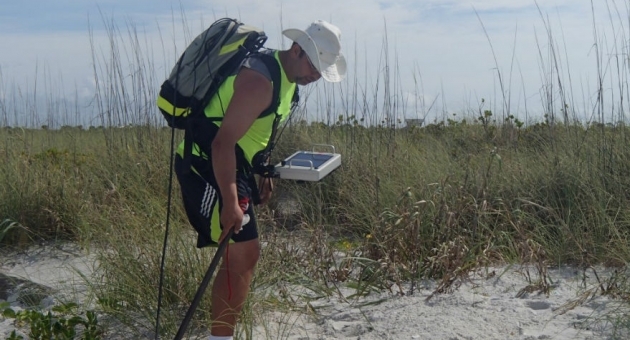Geologist helps find and protect endangered sea turtle nest

While at a state park off of the Gulf Coast of Florida to study the development of the shoreline, Assistant Professor of Earth and Environmental Science Ilya Buynevich used georadar to assist in locating and protecting the nest of an endangered green sea turtle.
Buynevich had been invited to Cayo Costa State Park—a pristine barrier island near Fort Myers—by Michael Savarese, professor of marine studies at Florida Gulf Coast University. They were using Temple’s georadar technology to X-ray the island and image changes in the ancient shorelines to develop a record of how the coastal barriers have developed over the past 3,000 years.
It turned out that the island is an important nesting location for the green sea turtle, which comes ashore between May and September to lay its eggs in pits dug several feet deep in the islands’ dunes. Before returning to the water, the turtles cover the nests with sand once they have laid their eggs.
Those nests are vulnerable to predators such as raccoons, foxes, coyotes, wild boars and other animals that unearth and eat the eggs. Park officials try to locate and protect the eggs from those predators by placing metal screening over discovered nests.
While Buynevich was using the georadar—which is as compact as a shoebox, with a wheel behind it—to image the shoreline, park rangers asked if the scientists could use the instrument to locate a nest dug by a turtle recently.
“I have been doing georadar imaging for 20 years, but it’s only been since I came to Temple in 2009 that I started imaging things like animal burrows,” said Buynevich, who sees forensic implications in identifying shallow-buried excavations, in addition to using noninvasive imaging for conservation and to search for ancient nests. “I have never tried to image something like this, so I thought it would be an interesting challenge.”
Buynevich said he made three short traverses over the dune area where it was suspected the turtle had laid its eggs before the radar produced an image that looked like a shallow excavation.
“I said, ‘Try here,’ so they dug down about two feet and found the eggs, which they then covered with metal screening to protect the nest from predators,” he said. “It literally looked like someone had dug a grave then filled it back up. On the surface, there was no way you could have recognized it as a turtle’s egg chamber.”